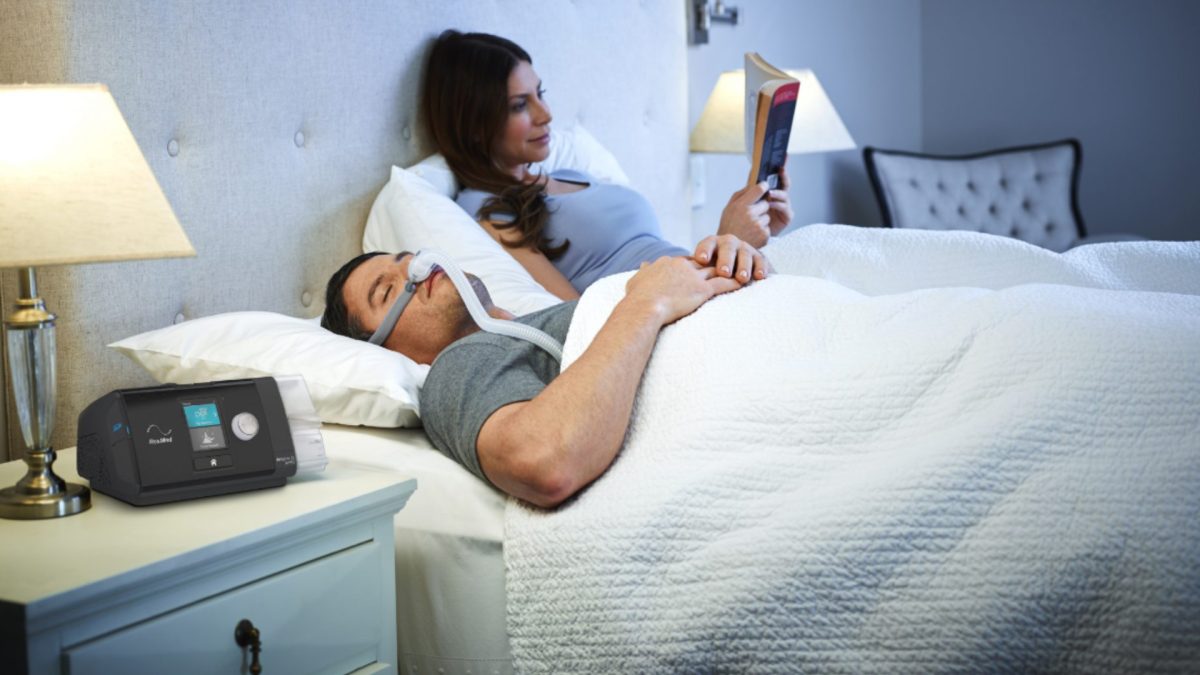CPAP Therapy
CPAP Therapy – Effective Sleep Apnoea Treatment
CPAP therapy is a powerful solution for treating Sleep Apnoea, a common sleep problem where breathing pauses during sleep. This therapy has transformed the management of Sleep Apnoea. It offers a lifeline to individuals struggling with the potentially severe consequences of untreated symptoms.
CPAP stands for Continuous Positive Airway Pressure. The therapy involves the use of a machine commonly known as a Sleep Apnoea machine. The machine delivers a constant stream of pressurised air through a mask worn during sleep.
The objective is to prevent the soft tissue in the upper airway from collapsing. This is the root cause of Obstructive Sleep Apnoea (OSA). The air pressure acts as a pneumatic splint, keeping the airway open and allowing for undisturbed breathing.
CPAP therapy is simple yet effective, suitable for various levels of OSA severity, from mild to severe cases. This makes it a first-line treatment option recommended by healthcare professionals worldwide.
The therapy helps make sure that air flows freely while you sleep, addressing the main issues that cause Sleep Apnoea symptoms. These symptoms often include loud snoring, choking or gasping during sleep. Consistent CPAP use can also significantly improve daytime fatigue.
People using CPAP therapy often experience an improvement in their overall well-being. Better sleep patterns increase alertness and improve brain function during the day. Reduced fatigue and better concentration contribute to a more active and productive daily life.
What is CPAP?
Clinically proven Sleep Apnoea treatment
CPAP therapy is a clinically proven treatment for OSA. Numerous studies and clinical trials have shown the efficacy of CPAP in managing the condition.
Clinical studies have shown that CPAP therapy can:
Improve Sleep Quality: CPAP therapy helps maintain continuous and unobstructed breathing, leading to improved sleep quality.
Reduce Daytime Fatigue: By preventing interruptions in breathing and enhancing sleep, CPAP can significantly reduce daytime fatigue and sleepiness.
Decrease Snoring: CPAP can reduce or completely stop the loud snoring associated with OSA.
Improve Memory: CPAP allows for continuous and restful sleep, linked to improved memory, concentration and energy levels.
Improve Heart & Lung Health: CPAP therapy enhances heart and lung health. It can reduce the risk of conditions such as hypertension and heart disease developing. The continuous flow of air pressure ensures optimal oxygen levels, reducing strain on the heart and lowering blood pressure.
Enhance Life Quality: CPAP therapy boosts the overall quality of life for individuals with Sleep Apnoea. It addresses the symptoms and potential health risks associated with untreated cases.

What does CPAP therapy consist of?
CPAP therapy (Continuous Positive Airway Pressure) consists of a CPAP machine and other key accessories. Here’s an overview of what therapy typically involves:
A CPAP Machine: The core component is the machine itself. The device is responsible for providing a continuous and pressurised airflow. Modern devices are often compact, quiet, and equipped with various features to enhance user comfort.
Mask: Users wear a mask over the nose, mouth, or both to deliver pressurised air from the machine to the airway. Various brands and types of masks are available. These include nasal masks, full-face masks, and nasal pillows. The choice of mask depends on user preferences and comfort.
Tubing: A flexible tube is used to connect the mask to the machine. The tubing allows the pressurised air to travel from the machine to the mask.
Filters: The machines have air filters that need regular cleaning or replacement. These filters help ensure that the air delivered by the machine is clean and free from allergens.
Humidifier (Optional): Some machines have a built-in humidifier or a detachable water chamber. This adds moisture to the airflow, reducing the risk of dryness or irritation in the nose and throat.

We are here to help
Explore some of our top pages to access popular information. If you are searching for a therapy device or accessories for Sleep Apnoea treatment, our wide range has all the options you may need. If you need help, our team is ready to answer any questions you may have.

CPAP Success
We have over 20 years of respiratory health experience and have helped 250,000 people across the UK and beyond. Our Sleep Apnoea testing and treatment can help you regain the quality sleep you need to live a better life.
We understand that beginning therapy can take some time to get used to, but with our support, you can find comfort in consistently using therapy. We pride ourselves on helping as many people as possible successfully use their CPAP equipment.
It can take up to a month to settle into using your machine and mask, and that’s why it’s so important to persevere. For many users, an unsuitable mask can prevent them from enjoying the full benefits of treatment. Others find difficulty adjusting to the air pressure or understanding their data. That’s why we can help you find the most suitable mask and offer comfort accessories and advice so you can sleep better and overcome any complications. We simplify your CPAP therapy compliance so you don’t have to worry.
Using your CPAP therapy every night will leave you feeling refreshed as well as reward you with:
- Improved your sleep
- Enhanced your mood
- Increased your energy levels
- Improved your memory
- Increased productivity
- Reduced snoring
While CPAP therapy requires commitment and adjustment, your quality of life will vastly improve.
The Risks of untreated Sleep Apnoea
Untreated Sleep Apnoea can have various risks that impact both short-term and long-term health. Here’s a simpler breakdown:
Feeling Tired All Day: Not treating the condition can make you feel super tired during the day. This can affect your energy and focus.
Forgetfulness: Memory loss is a common side effect because of constant broken sleep.
Low Concentration: Leaving the condition untreated can make it harder to focus on simple tasks.
Heart and Stroke Risk: Sleep Apnoea can strain your heart and increase your chances of high blood pressure, heart disease, and strokes.
Trouble with Sugar and Weight: The condition can mess with how your body handles sugar. It can make it easier to gain weight and increase the risk of diabetes.
Feeling Down: Individuals with untreated OSA can experience more symptoms of depression and anxiety.
Accident Risk: Because it makes you so tired during the day, the condition can increase the risk of car crashes or injuries at work.
Not Enjoying Life as Much: Overall, it can make it harder to enjoy life and do everyday things.
Surgical Risks: Untreated Sleep Apnoea can cause problems during surgery. This can be because of your breathing and how you react to medicine.
If you think you have Sleep Apnoea or are feeling these symptoms, you should talk to your GP or Sleep Clinic. You can also consider an In-Home Sleep Apnoea Test to avoid being on a waiting list.
Alternatives to CPAP Therapy
Several alternatives to CPAP therapy exist. The success of these is dependent on the severity of the condition.
Oral Appliances: Mandibular Advancement Devices (MAD) or tongue-retaining devices (TRD) are oral treatment options. They reposition the jaw or tongue to keep the airway open.
Positional Therapy: For individuals whose Sleep Apnoea is primarily position-dependent, positional therapy involves altering sleep positions to reduce airway obstruction.
Weight Management: Losing weight through diet and exercise may be effective for individuals with obesity-related Sleep Apnoea. However, it might not be a standalone solution for everyone.
Lifestyle Changes: Certain lifestyle choices can improve your sleep quality and reduce symptoms. Avoiding alcohol and sedatives, quitting smoking, and managing allergies can all contribute to improved sleep.
Surgery: Surgical options may be an option when anatomical factors contribute to airway obstruction.
It’s essential for individuals considering alternatives to CPAP therapy to work closely with their healthcare team. CPAP therapy stands as one of the most effective and widely recommended treatment options for Sleep Apnoea sufferers. Therapy relieves symptoms, and patients often experience improved sleep quality quickly.
Most users find the devices easy to use and maintain. Many accessories are also available to increase comfort levels and simplify therapy.


